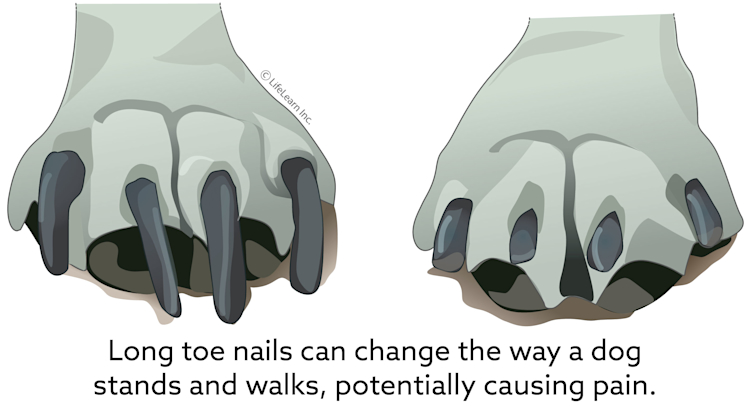Home | Medical Info | Senior Dog Care: Special Considerations
Senior Dog Care: Special Considerations
Keywords:
Senior Dog Care: Special Considerations
Dogs older than seven years of age are considered senior pets. Senior dogs are in the stage of life in which the aging process is beginning to affect every organ system. Some organs "wear out" faster or are more susceptible to cumulative damage than others, so certain observations are especially important to make. The following is a list of key recommendations that we feel are important for older dogs.
Keep vaccinations current. Your veterinarian will determine the proper vaccine schedule for your senior pet's lifestyle. Most senior pets will receive most vaccines every three years. Some vaccines with shorter duration of immunity such as the "kennel cough," Leptospirosis or Lyme disease vaccines may be given more frequently (every six to twelve months).
Have blood and urine tests evaluated at least once a year. Early detection of chronic diseases such as kidney disease, thyroid disease and diabetes is the key to successful treatment and preservation of quality of life.
Brush your pet frequently to prevent mats. This can contribute to skin infections and may hide skin tumors.
Clip toenails as needed to prevent overgrowth. Long toenails may cause the dog to stand and walk abnormally and result in pain or accelerate and exacerbate arthritic changes.
Featured Resources

We Welcome New Patients!
We're always happy to give your furry friend care at our hospital. Get in touch today!
Contact Us
Keep plenty of fresh water available and monitor its consumption. Increases in water consumption or urination are often associated with conditions such as diabetes, and kidney and liver disease.
Keep other pets from preventing your senior pet from access to food and water.
Keep your senior pet indoors most of the time, especially in inclement weather.
Weigh on the same scale and record results at least every two months. Changes in weight can be an early indicator of disease.
How often should I take my senior dog to the veterinarian?
"You should take your senior dog to the veterinarian at least once a year for an annual check-up."
You should take your senior dog to the veterinarian at least once a year for an annual check-up. It is very important to have your veterinarian examine your dog if you notice any of the following:
Sustained significant increase in water consumption. (normal water intake should be less than 100 ml/kg/day or approximately 1 ½ cups (12 ounces)/day for a 10-pound dog)
Sustained significant increase in urination.
Weight loss.
Significant decrease in appetite or failure to eat for more than two consecutive days.
Significant increase in appetite.
Repeated vomiting.
Diarrhea that lasts over three days.
Difficulty in passing stool or urine.
Sudden loss of housetraining.
Lameness that lasts more than three days, or lameness in more than one leg.
Noticeable decrease in vision, especially if sudden in onset or pupils that do not constrict in bright light.
Masses, ulcerations (open sores), or multiple scabs on the skin that persist for more than one week.
Foul mouth odor or drooling that lasts over two days.
An increase in the size of the abdomen.
Increasing inactivity or amount of time spent sleeping.
Hair loss, especially if accompanied by scratching, or if the loss is in specific areas (as opposed to generalized).
Persistent coughing or gagging.
Excessive panting.
Sudden collapse or bouts of weakness.
Inability to chew dry food.
A seizure (convulsion or "fit").
Senior Health Exams
Scheduling regular veterinary examinations is one of the most important steps pet owners can take to keep their pets in good health. When dogs and cats enter their senior years, these health examinations are more important than ever. Senior care, which starts with a regular veterinary exam, is needed to catch and delay the onset or progress of disease and for the early detection of problems such as organ failure and osteoarthritis. AAHA ( American Animal Hospital Association) recommends that healthy senior dogs and cats visit the veterinarian every six months for a complete exam and laboratory testing. Keep in mind that every year for a dog or cat is equivalent to 5–7 human years. In order to stay current with your senior pet’s health care, twice-a-year exams are a must. During the senior health exam, the veterinarian will ask you a series of questions regarding any changes in your pet’s activity and behavior.
The veterinarian will also conduct a complete examination of all of your pet’s body systems. Client education and laboratory testing are also key components of the senior exam.
Laboratory Testing
Veterinarians depend on laboratory results to help them understand the status of your pet’s health. When your pet is healthy, laboratory tests provide a means to determine your pet’s “baseline” values. When your pet is sick, the veterinarian can more easily determine whether or not your pet’s lab values are abnormal by comparing the baseline values to the current values and also can determine the trend in change of values. Subtle changes in these laboratory test results, even in the outwardly healthy animal, may signal the presence of an underlying disease. AAHA recommends that dogs and cats in middle age undergo laboratory tests at least annually. During the senior years, laboratory tests are recommended every six months for healthy dogs and cats. At a minimum, the following tests are recommended:
Complete Blood Count This common test measures the number of red blood cells, white blood cells, and platelets in a given sample of blood. The numbers and types of these cells give the veterinarian information needed to help diagnose anemia, infections, and leukemia. A complete blood count also helps veterinarians monitor your pet’s response to some treatments.
Urinalysis Laboratory analysis of urine is a tool used to detect the presence of one or more specific substances that normally do not appear in urine, such as protein, sugar, white blood cells, or blood. A measurement of the dilution or concentration of urine is also helpful in diagnosing diseases. Urinalysis can assist the veterinarian in the diagnosis of urinary-tract infections, diabetes, dehydration, kidney problems, and many other conditions.
Cystocentesis (Cysto)- the direct removal of urine from the bladder with a needle. The safest, cleanest, easiest method of urine sampling, especially in cats.
Blood-Chemistry Panel Blood-chemistry panels measure electrolytes, enzymes, and chemical elements such as calcium and phosphorous. This information helps your veterinarian determine how various organs, such as the kidneys, pancreas, and liver, are currently functioning. The results of these tests help your veterinarian formulate an accurate diagnosis, prescribe proper therapy, and monitor the response to treatment. Further testing may be recommended based on the results of these tests.
Thyroid Level (T4)- A blood test to measure the amount of circulating thyroid hormone. Deficiency of Thyroxine (Hypothyroidism) is common in dogs resulting in lethargy, weight gain, and dermatological problems. Increased levels of thyroxine (Hyperthyroidism) are common in senior cats resulting in weight loss, increased appetite and thirst, and heart problems.
Glaucoma Screening:
Parasite Evaluation Microscopic examination of your pet’s feces can provide information about many different kinds of diseases, such as difficulties with digestion, internal bleeding, and disorders of the pancreas. Most importantly, though, this test confirms the presence of intestinal parasites, such as roundworm, hookworm, whipworm, tapeworm, and giardia.
Radiographs/Ultrasound- Imaging studies allow visualization of many internal organs including the bladder, liver, spleen, kidney, pancreas, and heart. These are especially useful in the diagnosis of cardiac problems as well as abdominal growths and tumors.
Additionally, depending on your individual pet’s condition and other factors, other tests and assessments might be recommended. These include heartworm tests; feline leukemia/feline immunodeficiency virus test in cats; blood pressure evaluation; urine protein evaluation; cultures; imaging such as x-rays, ultrasound, and echocardiography; electrocardiography, and special ophthalmic evaluations, among others. Additional tests become especially important in evaluating senior pets that show signs of sickness or are being prepared for anesthesia and surgery.
The Effects of Age
Sensory responses change with the senior years, coming to a general “slowing down” in pets. As their major senses (sight, hearing, taste, touch, and smell) dull, you may find that your pet has a slower response to general external stimuli. This loss of sensory perception often is a slow, progressive process, and it may even escape your notice. The best remedy for gradual sensory reduction is to keep your pet active—playing and training are excellent ways to keep their senses sharp. Pets may also be affected mentally as they age. Just as aging humans begin to forget things and are more susceptible to mental conditions, your aging animals may also begin to confront age-related cognitive and behavior changes. Most of these changes are rather subtle and can be addressed in a proactive manner. Regular senior health exams can help catch and treat these problems before they control your pet’s life.
Physical Changes
The physical changes your pets experience are generally easier to spot than the sensory changes. As the body wears out, its ability to respond to infection is reduced, and the healing process takes longer. Therefore, it is crucial to consult a veterinarian if you notice a significant change in behavior or the physical condition of your pet. Many of the signs indicating that animals are approaching senior citizenship are the same for both cats and dogs, but they can indicate a variety of different problems (see Signs of a Problem, below). A very common and frustrating problem for aging pets is inappropriate elimination. The kidneys are one of the most common organ systems to wear out on a cat or dog, and as hormone imbalance affects the function of the kidneys, your once well-behaved pet may have trouble controlling his bathroom habits. If you are away all day, he may simply not be able to hold it any longer, or urine may dribble out while he sleeps at night. In addition, excessive urination or incontinence may be indicative of diabetes or kidney failure, both of which are treatable if caught early enough.
Nutrition
Many older pets benefit from specially formulated food that is designed with older bodies in mind. Obesity in pets is often the result of reduced exercise and overfeeding and is a risk factor for problems such as heart disease. Because older pets often have different nutritional requirements, these special foods can help keep your pet’s weight under control and reduce consumption of nutrients that are risk factors for the development of diseases, as well as organ- or age-related changes.
Exercise
Exercise is yet another aspect of preventive geriatric care for your pets. You should definitely keep them going as they get older—if they are cooped up or kept lying down, their bodies will deteriorate much more quickly. You may want to ease up a bit on the exercise with an arthritic or debilitated cat or dog. Otherwise, you should keep them as active—mentally and physically—as possible in order to keep them sharp. Surgery for the Older Pet In the event your veterinarian is considering surgery or any other procedure in which anesthesia is needed, special considerations are taken to help ensure the safety of your senior pet. AAHA recommends all senior dogs and cats undergo the laboratory testing mentioned above, ideally within two weeks of any anesthetized procedure. A blood pressure evaluation and additional tests might also be recommended, depending on your individual pet. These screening tools can provide critical information to the health care team to help determine the proper anesthesia and drug protocol for your pet, as well as make you aware of any special risk factors that might be encountered.
Pain Management
Pets experience pain just like humans do, The AAHA guidelines encourage veterinarians to use pain assessment as the fourth vital sign (along with temperature, pulse, and respiration). The different types of pain include acute pain, which comes on suddenly as a result of an injury, surgery, or an infection, and chronic pain, which is long-lasting and usually develops slowly (such as arthritis). You can play a key role in monitoring your pet to determine whether he suffers from pain. To help ensure your pet lives comfortably during the senior life stage, it’s critical to work with your veterinarian to tailor a senior wellness plan that is best for your dog or cat. Be sure to monitor the behavior and physical conditions and report anything unusual to your veterinarian, who can help your pet head into the twilight years with ease.
Featured Resources

We Welcome New Patients!
We're always happy to give your furry friend care at our hospital. Get in touch today!
Contact UsTips and Advice From Our Team
Looking for advice about caring for your pet? Our blog features helpful tips and educational material from our team to support your needs.


